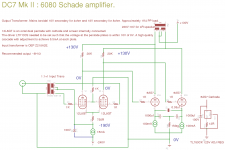Brit01
You may want to check out this thread.
It has the schematic for Atmasphere M60 OTL.
http://www.diyaudio.com/forums/tubes-valves/161112-what-tubes-tube-amp-3.html
You may want to check out this thread.
It has the schematic for Atmasphere M60 OTL.
http://www.diyaudio.com/forums/tubes-valves/161112-what-tubes-tube-amp-3.html
___ by putting a 6SL7 or similar as a driver and removing the first stage. By ___doing this I'm trying to take full advantage of the low Miller capacitance ___he 6AS7 by using a high gain low current driver. That's for the new year.
___As it is though the amp sounds simply beautiful.
I'm hoping to use a 3A5 (4.5 mA x 2), or two of them, in place of the 6922 (12 mA x 2) in a van Waarde 6as7 SE headphone amp. I thought maybe I could get away with it because a headphone amp only has to crank maybe 150 mW. Does this sound reasonable? I'm assuming the preamp tube has to have the current drive to charge and push past this Miller capacitance?
3a5 is said to have a 'liquid sound', which sounds like a great idea to me!
___As it is though the amp sounds simply beautiful.
I'm hoping to use a 3A5 (4.5 mA x 2), or two of them, in place of the 6922 (12 mA x 2) in a van Waarde 6as7 SE headphone amp. I thought maybe I could get away with it because a headphone amp only has to crank maybe 150 mW. Does this sound reasonable? I'm assuming the preamp tube has to have the current drive to charge and push past this Miller capacitance?
3a5 is said to have a 'liquid sound', which sounds like a great idea to me!
Sorry I think the 6C19P has a resistance of 400 not 120 no?
I have 4 x 6080 tubes (280 ohms). Might give this a shot with just one channel to start with.
I'll need some beefy heater supplies.
Maybe a 25V 4Amp tranny.
That still represents a very high output impedance and hence a very poor damping factor, expect very sloppy bass. Mains toroidals can be got of E-bay for small money.
Shoog
All my amps use mains toroidals and they certainly are well received by the Golden eared crowd.
A mains toroidal in a push pull arrangement will match or outperform almost all commercial OT. They work very well if you make certain there is almost no DC in the transformer (less than 2mA) and that the output pair have a fairly low output impedance. I have used Schaded 807 PP outputs without issue at 6K PP load.
Interwinding capacitance can be high, but polarity of the Primary side can avoid big issues (one direction is likely to ring producing core saturation which creates a drop off at low frequencies and a peaky response at high, the other direction will be much better).
Thats all you need to know to make it work.
Shoog
A mains toroidal in a push pull arrangement will match or outperform almost all commercial OT. They work very well if you make certain there is almost no DC in the transformer (less than 2mA) and that the output pair have a fairly low output impedance. I have used Schaded 807 PP outputs without issue at 6K PP load.
Interwinding capacitance can be high, but polarity of the Primary side can avoid big issues (one direction is likely to ring producing core saturation which creates a drop off at low frequencies and a peaky response at high, the other direction will be much better).
Thats all you need to know to make it work.
Shoog
Many thanks; I am used to using current sinks in double ended circuits so the DC issue should be capable of being solved(if I AC couple the cathodes). Your reply has given me confidence to finish this one off-great. Also,regards to the Emerald Isle-I come from Belfast originally.
Great city. Was just up in Derry and Antrim a few days ago. Live in Roscommon myself.
Look at my circuit in post 19 for how to address the DC and AC issues. This is my standard cathode arrangement on all my amps, it sounds great and has never let me down. I also used a Garter bias on one but that wastes a bit more voltage.
Shoog
Look at my circuit in post 19 for how to address the DC and AC issues. This is my standard cathode arrangement on all my amps, it sounds great and has never let me down. I also used a Garter bias on one but that wastes a bit more voltage.
Shoog
Last edited:
I built that amp and it sounded fabulous, but it did have roll off issues with the toroidal phase splitter. It pushes 30mA into the phase splitter and still starts to roll off noticably at about 50kHz. My latest version is direct coupled with a phase splitter transformer at the front end. This makes the transformer a lot more affordable and better performing. See attachment. I have used a toroidal phase splitter as an input transformer where the grid load is reduced, but the times I did it I had gain to burn so stepped down by about 4:1 which improves things no end. Tube gain is cheap - decent phase splitting transformer are not, so its well worth the effort.
The Garter bias is discussed here;
Amplifier auto bias circuits: Alan Dower Blumlein's garter circuit
Shoog
The Garter bias is discussed here;
Amplifier auto bias circuits: Alan Dower Blumlein's garter circuit
Shoog
Attachments
- Status
- This old topic is closed. If you want to reopen this topic, contact a moderator using the "Report Post" button.
- Home
- Amplifiers
- Tubes / Valves
- Simplest 6080 or 6AS7 OTL Project?
